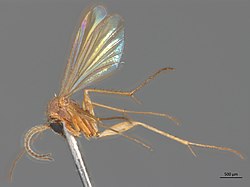Biology:Sciophila fractinervis
| Sciophila fractinervis | |
|---|---|

| |
| Scientific classification | |
| Kingdom: | Animalia
|
| Phylum: | |
| Class: | |
| Order: | |
| Family: | |
| Subfamily: | |
| Genus: | |
| Species: | S. fractinervis
|
| Binomial name | |
| Sciophila fractinervis | |
Sciophila fractinervis is a species of fungus gnat in the family Mycetophilidae.
Distribution
Sciophila fractinervis is a tropical species and was originally described in 1940 by Frederick Wallace Edwards using specimens collected by Friedrich 'Fritz' Plaumann from the neighbourhood of Nova Teutonia, Santa Catarina, Brazil.[1] S. fractinervis has been found on cultivated greenhouse plants in the United Kingdom[2] and was recorded by Peter J. Chandler in 2010 on examples of commercially-grown Eustoma grandiflorum from Warwickshire. [3] This species was also recorded on greenhouse examples of Platycerium and Beaucarnea in the Netherlands in 2005.[4] S. fractinervis is considered by RINSE (Registry of non-native species in the Two Seas region countries) as a non-native species in Great Britain, France, Belgium and the Netherlands.[5]
Description
The larvae of Sciophila fractinervis are brown in colour and have a glossy appearance, due to being enclosed in a mucus tube created from labial glands around the mouth.[2]
The adults have a dark grey head with a yellowish face, a yellowish thorax, brown abdomen and yellow legs.[1][3] The mouthparts are black.[1] The wings of the male measure 2.5 - 2.7mm and the wings of the female are 2.9 - 3.2mm.[3][4] Females of the species have shorter antennae than males.[1]
Edwards observed that the macrotrichia (hairs or bristles) on the wings of S. fractinervis are less dense, and therefore more conspicuous than on the comparable species Sciophila ciliata.[1]
Life cycle
Sciophila fractinervis larvae build silky cocoons of webbing either on the basal leaves of their host plant or on the soil underneath.[3] The larvae eat fungus spores which grow upon the webbing to sustain themselves, mainly from saprophytic species of fungus that feed on decaying plant matter.[2] The webbing built by the larvae likely also provides a protective environment against predators as larvae have been observed retreating when the webbing is suddenly vibrated.[2] The leaves of the host plant do not appear to be damaged by the larval activity, at least in cultivated plant examples[2][3] but the webbing is considered unsightly by commercial plant growers.[2] The larvae take about 7-10 days to pupate and emerge as adults.[3][2]
References
- ↑ 1.0 1.1 1.2 1.3 1.4 Edwards, Frederick Wallace (June 1940). "New Neotropical Mycetophilidae (IV) (Diptera)". Revista de Entomologia (Rio de Janeiro) 11 (1-2): 440-465.
- ↑ 2.0 2.1 2.2 2.3 2.4 2.5 2.6 Deady, Rob J.; Delaney, Mark A.; Jones, Eleanor; Chandler, Peter J.. "Further interceptions of the Neotropical fungus gnat Sciophila fractinervis Edwards, 1940 (Diptera, Mycetophilidae) in Britain with comments and observations on its biology and spread". https://bdj.pensoft.net/article/94812/.
- ↑ 3.0 3.1 3.2 3.3 3.4 3.5 Chandler, Peter John (2010). "The South American fungus gnat Sciophila fractinervis (Edwards, 1940) (Diptera, Mycetophilidae) present in Britain". Dipterists Digest 17 (1): 50-52. https://dipterists.org.uk/sites/default/files/pdf/Dipterists%20Digest%202010%20Vol%2017%20No%201.pdf.
- ↑ 4.0 4.1 Chandler, Peter; Pijnakker, Juliette (January 2009). "Tropical fungus gnats established in nurseries in the Netherlands (Diptera: Keroplatidae and Mycetophilidae)". British Journal of Entomology and Natural History 22 (2): 81-93. https://www.researchgate.net/publication/273180579_Tropical_fungus_gnats_established_in_nurseries_in_the_Netherlands_Diptera_Keroplatidae_and_mycetophilidae.
- ↑ "Sciophila fractinervis". https://www.gbif.org/species/145960599.
Wikidata ☰ Q14711613 entry
 |


